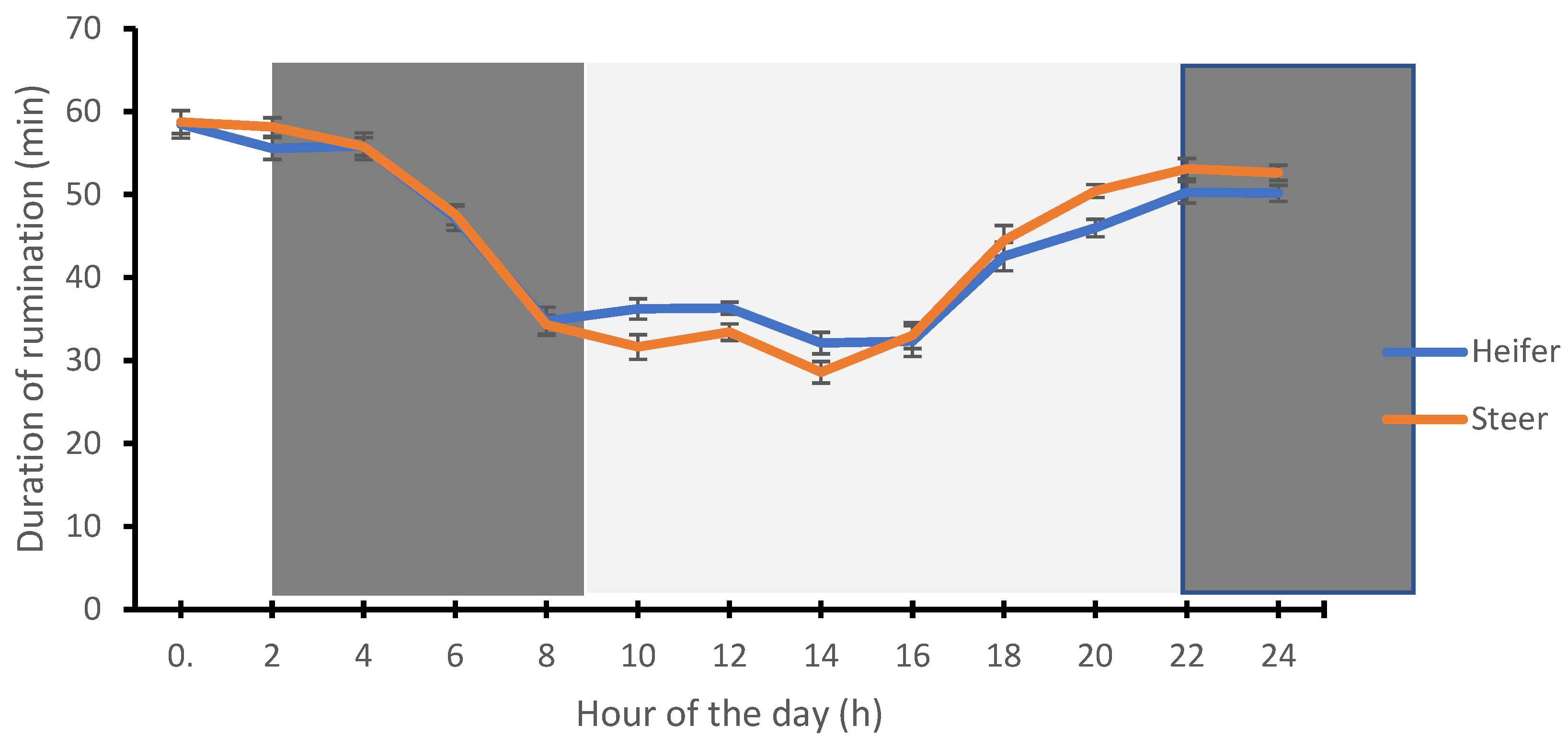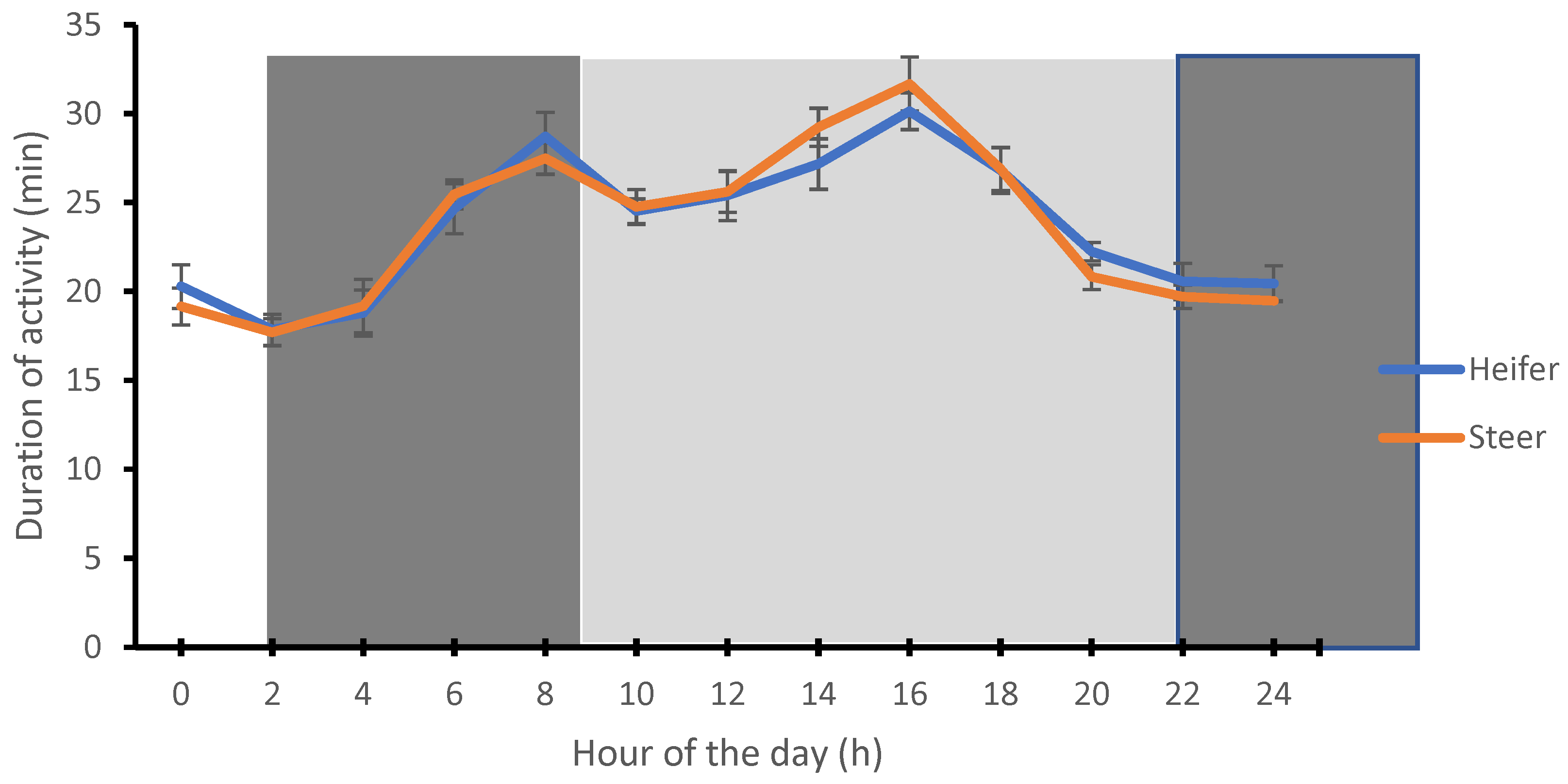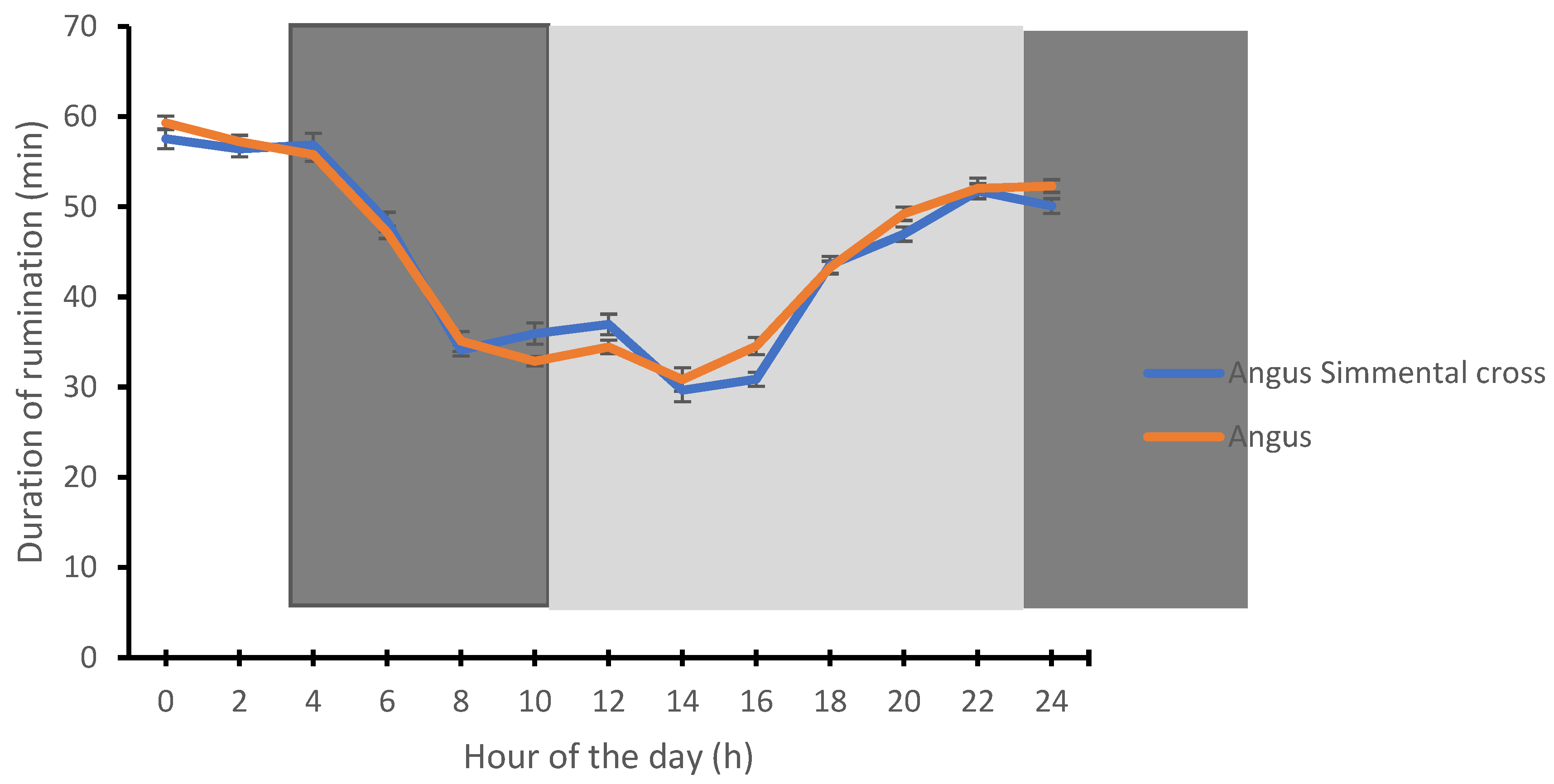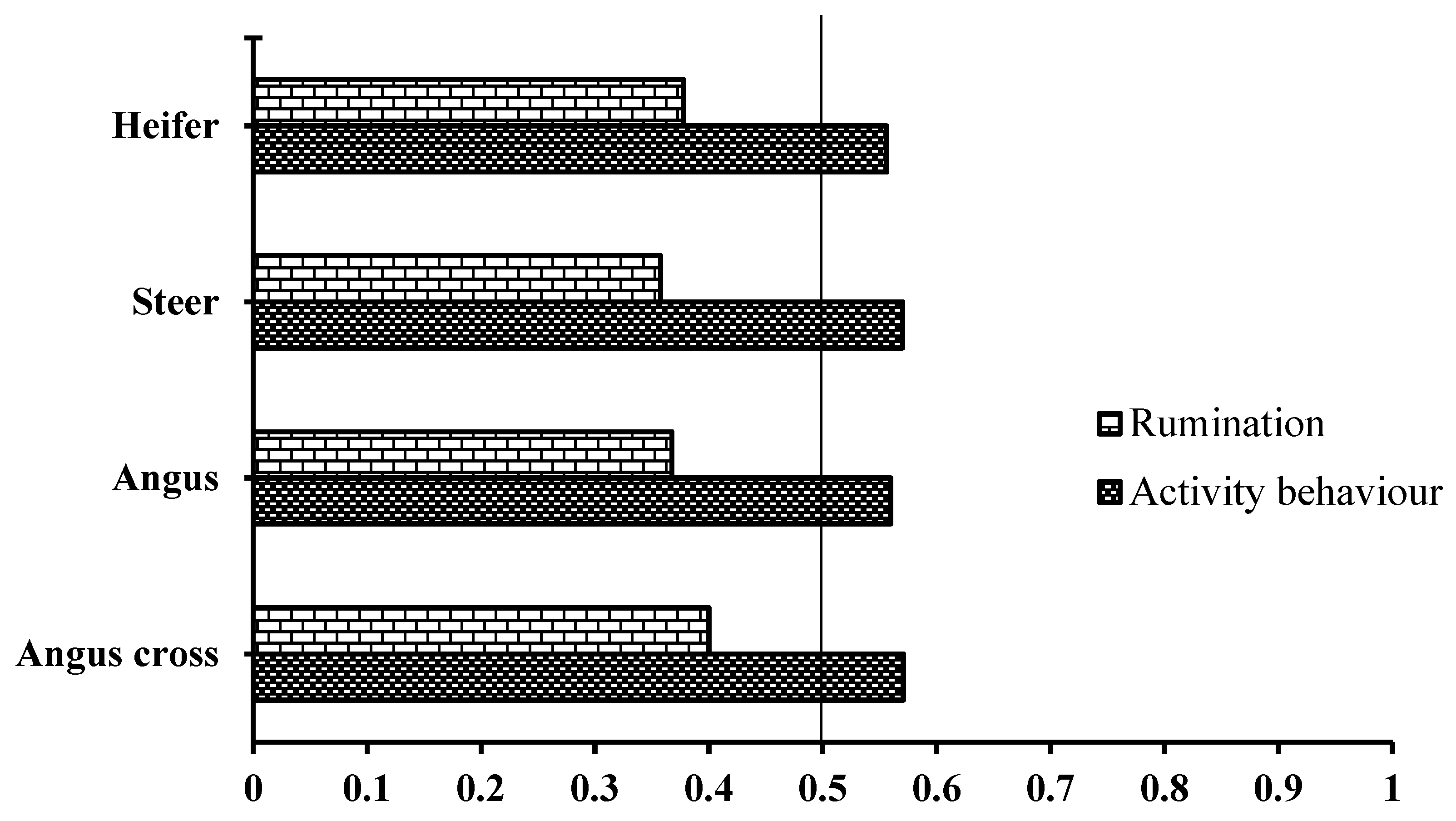Rumination and Activity Patterns in Angus and Angus-Cross Beef Calves: Influences of Sex, Breed, and Backgrounding Diet
Abstract
Simple Summary
Abstract
1. Introduction
2. Materials and Methods
2.1. Animals and Preweaning Management
2.2. Experimental Design
2.3. Backgrounding Management and Dietary Treatments
2.4. Feedlot Management
2.5. Evaluation of Activity Behavior and Rumination in Beef Calves
2.6. Measurement of Environmental Parameters
2.7. Statistical Analysis
3. Results
3.1. Environmental Parameters during the Study Period
3.2. Effects of Sex, Breed, and Backgrounding System on Rumination and Activity in Beef Calves
3.3. Effects of Circadian Rhythm on Rumination and Activity Behavior in Beef Calves
3.4. The Diurnality Index of Activity Behavior and Rumination during the Study Period
3.5. Relationships between Rumination and Activity Behavior in Beef Calves
3.6. Relationships between Environmental Parameters, Rumination, and Activity Behavior in Beef Calves
4. Discussion
5. Conclusions
Author Contributions
Funding
Institutional Review Board Statement
Informed Consent Statement
Data Availability Statement
Acknowledgments
Conflicts of Interest
References
- Welch, J.G. Rumination, particle size and passage from the rumen. J. Anim. Sci. 1982, 549, 885–894. [Google Scholar] [CrossRef]
- Beauchemin, K.A. Effects of dietary neutral detergent fiber concentration and alfalfa hay quality on chewing, rumen function, and milk production of dairy cows. J. Dairy Sci. 1991, 74, 3140–3151. [Google Scholar] [CrossRef]
- Radostits, O.M.; Gay, C.C.; Hinchcliff, K.W.; Constable, P.D. Veterinary Medicine: A Textbook of the Diseases of Cattle, Horses, Sheep, Pigs and Goats, 10th ed.; Saunders Ltd.: Philadelphia, PA, USA, 2007; p. 268. [Google Scholar]
- Schirmann, K.; Chapinal, N.; Weary, D.M.; Heuwieser, W.; Von Keyserlingk, M.A.G. Short-term effects of regrouping on behavior of prepartum dairy cows. J. Dairy Sci. 2011, 94, 2312–2319. [Google Scholar] [CrossRef] [PubMed]
- DeVries, T.J.; Beauchemin, K.A.; Dohme, F.; Schwartzkopf-Genswein, K.S. Repeated ruminal acidosis challenges in lactating dairy cows at high and low risk for developing acidosis: Feeding, ruminating, and lying behavior. J. Dairy Sci. 2009, 92, 5067–5078. [Google Scholar] [CrossRef] [PubMed]
- Espejo, L.A.; Endres, M.I. Herd-level risk factors for Lameness in high-producing Holstein cows housed in freestall barns. J. Dairy Sci. 2007, 90, 306–314. [Google Scholar] [CrossRef]
- Soriani, N.; Trevisi, E.; Calamari, L. Relationships between rumination time, metabolic conditions, and health status in dairy cows during the transition period. J. Anim. Sci. 2012, 90, 4544–4554. [Google Scholar] [CrossRef]
- Webb, L.E.; Bokkers, E.A.M.; Engel, B.; Gerrits, W.J.J.; Berends, H.; Van Reenen, C.G. Behaviour and welfare of veal calves fed different amounts of solid feed supplemented to a milk replacer ration adjusted for similar growth. Appl. Anim. Behav. Sci. 2012, 136, 108–116. [Google Scholar] [CrossRef]
- Eslamizad, M.; Tümmler, L.M.; Derno, M.; Hoch, M.; Kuhla, B. Development of a pressure sensor-based system for measuring rumination time in pre-weaned dairy calves. J. Anim. Sci. 2018, 96, 4483–4489. [Google Scholar] [CrossRef]
- Ametaj, B.N.; Zebeli, Q.; Saleem, F.; Psychogios, N.; Lewis, M.J.; Dunn, S.M.; Wishart, D.S. Metabolomics reveals unhealthy alterations in rumen metabolism with increased proportion of cereal grain in the diet of dairy cows. Metabolomics 2010, 6, 583–594. [Google Scholar] [CrossRef]
- Llonch, P.; Mainau, E.; Ipharraguerre, I.R.; Bargo, F.; Tedó, G.; Blanch, M.; Manteca, X. Chicken or the egg: The reciprocal association between feeding behavior and animal welfare and their impact on productivity in dairy cows. Front. Vet. Sci. 2018, 5, 305. [Google Scholar] [CrossRef]
- Lindgren, E. Validation of Rumination Measurement Equipment and the Role of Rumination in Dairy Cow Time Budgets. University of Agricultural Sciences Uppsala. Available online: http://stud.epsilon.slu.se/629/1/Lindgren_e_091120.pdf (accessed on 21 February 2009).
- Gáspárdy, A.; Efrat, G.; Bajcsy, Á.; Fekete, S. Electronic monitoring of rumination activity as an indicator of health status and production traits in high-yielding dairy cows. Acta Vet. Hung. 2014, 62, 452–462. [Google Scholar] [CrossRef] [PubMed]
- Weary, D.M.; Huzzey, J.M.; Von Keyserlingk, M.A. Using behavior to predict and identify ill health in animals. J. Anim. Sci. 2009, 87, 770–777. [Google Scholar] [CrossRef] [PubMed]
- Marchesini, G.; Mottaran, D.; Contiero, B.; Schiavon, E.; Segato, S.; Garbin, E.; Andrighetto, I. Use of rumination and activity data as health status and performance indicators in beef cattle during the early fattening period. Vet. J. 2018, 231, 41–47. [Google Scholar] [CrossRef]
- Adin, G.; Solomon, R.; Nikbachat, M.; Zenou, A.; Yosef, E.; Brosh, A.; Miron, J. Effect of feeding cows in early lactation with diets differing in roughage-neutral detergent fiber content on intake behavior, rumination, and milk production. J. Dairy Sci. 2009, 92, 3364–3373. [Google Scholar] [CrossRef]
- Welch, J.G.; Smith, A.M.; Gibson, K.S. Rumination time in four breeds of dairy cattle. J. Dairy Sci. 1970, 53, 89–91. [Google Scholar] [CrossRef]
- Bae, D.H.; Welch, J.G.; Gilman, B.E. Mastication and rumination in relation to body size of cattle. J. Dairy Sci. 1983, 66, 2137–2141. [Google Scholar] [CrossRef]
- Pahl, C.; Hartung, E.; Grothmann, A.; Mahlkow-Nerge, K.; Haeussermann, A. Rumination activity of dairy cows in the 24 h before and after calving. J. Dairy Sci. 2014, 97, 6935–6941. [Google Scholar] [CrossRef] [PubMed]
- Ambriz-Vilchis, V.; Jessop, N.S.; Fawcett, R.H.; Shaw, D.J.; Macrae, A.I. Comparison of rumination activity measured using rumination collars against direct visual observations and analysis of video recordings of dairy cows in commercial farm environments. J. Dairy Sci. 2015, 98, 1750–1758. [Google Scholar] [CrossRef]
- Braun, U.; Zürcher, S.; Hässig, M. Evaluation of eating and rumination behaviour in 300 cows of three different breeds using a noseband pressure sensor. BMC Vet. Res. 2015, 11, 1–6. [Google Scholar] [CrossRef]
- Beauchemin, K.A. Invited review: Current perspectives on eating and rumination activity in dairy cows. J. Dairy Sci. 2018, 101, 4762–4784. [Google Scholar] [CrossRef]
- Paudyal, S.; Maunsell, F.P.; Richeson, J.T.; Risco, C.A.; Donovan, D.A.; Pinedo, P.J. Rumination time and monitoring of health disorders during early lactation. Animal 2018, 12, 1484–1492. [Google Scholar] [CrossRef] [PubMed]
- Omontese, B.O.; Bisinotto, R.S.; Cramer, G. Evaluating the association between early-lactation lying behavior and hoof lesion development in lactating Jersey cows. J. Dairy Sci. 2020, 103, 10494–10505. [Google Scholar] [CrossRef] [PubMed]
- Thomson, D.U.; White, B.J. Backgrounding beef cattle. Vet. Clin. Food Anim. Pract. 2006, 22, 373–398. [Google Scholar] [CrossRef]
- Peel, D.S. Beef cattle growing and backgrounding programs. Vet. Clin. Food Anim. Pract. 2003, 19, 365–385. [Google Scholar] [CrossRef]
- Perillat, B.J.; Brown, W.J.; Cohen, R.D.H. A risk efficiency analysis of backgrounding and finishing steers on pasture in Saskatchewan, Canada. Agric. Syst. 2004, 80, 213–233. [Google Scholar] [CrossRef]
- Klinger, S.A.; Block, H.C.; McKinnon, J.J. Nutrient digestibility, fecal output and eating behavior for different cattle background feeding strategies. Can. J. Anim. Sci. 2007, 87, 393–399. [Google Scholar] [CrossRef]
- Golombek, D.A.; Rosenstein, R.E. Physiology of circadian entrainment. Physiol. Rev. 2010, 90, 1063–1102. [Google Scholar] [CrossRef]
- Piccione, G.; Caola, G.; Refinetti, R. Temporal relationships of 21 physiological variables in horse and sheep. Comp. Biochem. Physiol. A. Mol. Integr. Physiol. 2005, 142, 389–396. [Google Scholar] [CrossRef]
- Berger, J.; Slapničková, M. Circadian structure of rat neutrophil phagocytosis. Comp. Clin. Pathol. 2003, 12, 84–89. [Google Scholar] [CrossRef]
- Bloch, G.; Barnes, B.M.; Gerkema, M.P.; Helm, B. Animal activity around the clock with no overt circadian rhythms: Patterns, mechanisms and adaptive value. Proc. Biol. Sci. 2013, 280, 20130019. [Google Scholar] [CrossRef]
- Petty, T.W.; Cecava, M.J. (Eds.) Beef Cattle Feeding and Nutrition; Elsevier: Amsterdam, The Netherlands, 1995. [Google Scholar]
- Spigarelli, C.; Zuliani, A.; Battini, M.; Mattiello, S.; Bovolenta, S. Welfare assessment on pasture: A review on animal-based measures for ruminants. Animals 2020, 10, 609. [Google Scholar] [CrossRef] [PubMed]
- Piccione, G.; Giannetto, C.; Casella, S.; Caola, G. Daily locomotor activity in five domestic animals. Anim. Biol. 2010, 60, 15–24. [Google Scholar]
- Grant, R.J.; Colenbrander, V.F.; Albrigh, J.L. Effect of particle size of forage and rumen cannulation upon chewing activity and laterality in dairy cows. J. Dairy Sci. 1990, 73, 3158–3164. [Google Scholar] [CrossRef]
- Dado, R.G.; Allen, M.S. Variation in and relationships among feeding, chewing, and drinking variables for lactating dairy cows. J. Dairy Sci. 1994, 77, 132–144. [Google Scholar] [CrossRef]
- Paudyal, S.; Maunsell, F.; Richeson, J.; Risco, C.; Donovan, A.; Pinedo, P. Peripartal rumination dynamics and health status in cows calving in hot and cool seasons. J. Dairy Sci. 2016, 99, 9057–9068. [Google Scholar] [CrossRef] [PubMed]
- Nikkhah, A. Chronophysiology of ruminant feeding behavior and metabolism: An evolutionary review. Biol. Rhythm Res. 2013, 44, 197–218. [Google Scholar] [CrossRef]
- Reith, S.; Brandt, H.; Hoy, S. Simultaneous analysis of activity and rumination time, based on collar-mounted sensor technology, of dairy cows over the periestrus period. Livest. Sci. 2014, 170, 219–227. [Google Scholar] [CrossRef]
- Roelofs, J.B.; Van Eerdenburg, F.J.; Soede, N.M.; Kemp, B. Pedometer readings for estrous detection and as predictor for time of ovulation in dairy cattle. Theriogenology 2005, 64, 1690–1703. [Google Scholar] [CrossRef]
- Van Vliet, J.H.; Van Eerdenburg, F.J.C.M. Sexual activities and oestrus detection in lactating Holstein cows. Appl. Anim. Behav. Sci. 1996, 50, 57–69. [Google Scholar] [CrossRef]
- Taweel, H.Z.; Tas, B.M.; Dijkstra, J.; Tamminga, S. Intake regulation and grazing behavior of dairy cows under continuous stocking. J. Dairy Sci. 2004, 87, 3417–3427. [Google Scholar] [CrossRef]
- Peralta, O.A.; Pearson, R.E.; Nebel, R.L. Comparison of three estrus detection systems during summer in a large commercial dairy herd. Anim. Reprod. Sci. 2005, 87, 59–72. [Google Scholar] [CrossRef]
- Gregorini, P.; Gunter, S.A.; Beck, P.A.; Soder, K.J.; Tamminga, S. Review: The interaction of diurnal grazing pattern, ruminal metabolism, nutrient supply and management in cattle. Prof. Anim. Sci. 2008, 24, 308–318. [Google Scholar] [CrossRef]
- Schirmann, K.; Chapinal, N.; Weary, D.M.; Heuwieser, W.; Von Keyserlingk, M.A. Rumination and its relationship to feeding and lying behavior in Holstein dairy cows. J. Dairy Sci. 2012, 95, 3212–3217. [Google Scholar] [CrossRef]
- Clark, C.E.F.; Lyons, N.A.; Millapan, L.; Talukder, S.; Cronin, G.M.; Kerrisk, K.L.; Garcia, S.C. Rumination and activity levels as predictors of calving for dairy cows. Animal 2015, 9, 691–695. [Google Scholar] [CrossRef] [PubMed]
- Rodrigues, J.P.P.; Pereira, L.G.R.; Neto, H.D.C.D.; Lombardi, M.C.; De Assis Lage, C.F.; Coelho, S.G.; Campos, M.M. Evaluation of an automatic system for monitoring rumination time in weaning calves. Livest. Sci. 2019, 219, 86–90. [Google Scholar] [CrossRef]
- Nikkhah, A. Ruminant chronophysiological management: An emerging bioscience. Open Access Anim. Physiol. 2011, 3, 9–12. [Google Scholar] [CrossRef][Green Version]
- Deswysen, A.G.; Dutilleul, P.A.; Ellis, W.C. Quantitative analysis of nycterohemeral eating and ruminating patterns in heifers with different voluntary intakes and effects of monensin. J. Anim. Sci. 1989, 67, 2751–2761. [Google Scholar] [CrossRef] [PubMed]
- Krause, K.M.; Combs, D.K.; Beauchemin, K.A. Effects of forage particle size and grain fermentability in mid-lactation cows. II. Ruminal pH and chewing activity. J. Dairy Sci. 2002, 85, 1947–1957. [Google Scholar] [CrossRef]
- Giannetto, C.; Fazio, F.; Assenza, A.; Caola, G.; Pennisi, P.; Piccione, G. Circadian rhythms of redox states and total locomotor activity in dairy cattle. Czech J. Anim. Sci. 2010, 55, 183–189. [Google Scholar] [CrossRef]
- Sheahan, A.J.; Kolver, E.S.; Roche, J.R. Genetic strain and diet effects on grazing behavior, pasture intake, and milk production. J. Dairy Sci. 2011, 94, 3583–3591. [Google Scholar] [CrossRef]
- Stone, A.E.; Jones, B.W.; Becker, C.A.; Bewley, J.M. Influence of breed, milk yield, and temperature-humidity index on dairy cow lying time, neck activity, reticulorumen temperature, and rumination behavior. J. Dairy Sci. 2017, 100, 2395–2403. [Google Scholar] [CrossRef] [PubMed]
- Carvalho, P.H.; Pinto, A.C.; Millen, D.D.; Felix, T.L. Effect of cattle breed and basal diet on digestibility, rumen bacterial communities, and eating and rumination activity. J. Anim. Sci. 2020, 98, skaa114. [Google Scholar] [CrossRef] [PubMed]
- Beauchemin, K.A.; Zelin, S.; Genner, D.; Buchanan-Smith, J.G. An automatic system for quantification of eating and ruminating activities of dairy cattle housed in stalls. J. Dairy Sci. 1989, 72, 2746–2759. [Google Scholar] [CrossRef]
- Elischer, M.F.; Arceo, M.E.; Karcher, E.L.; Siegford, J.M. Validating the accuracy of activity and rumination monitor data from dairy cows housed in a pasture-based automatic milking system. J. Dairy Sci. 2013, 96, 6412–6422. [Google Scholar] [CrossRef]
- Wang, M.; Alves, J.; Tucker, M.; Yang, W.; Ruckstuhl, K.E. Effects of intrinsic and extrinsic factors on ruminating, grazing, and bedding time in bighorn sheep (Ovis canadensis). PLoS ONE 2018, 13, e0206664. [Google Scholar] [CrossRef]
- Vargas Junior, F.M.D.; Wechsler, F.S.; Rossi, P.; Oliveira, M.V.M.D.; Schmidt, P. Ingestive behavior of Nellore cows and their straightbred or crossbred calves. Rev. Bras. Zootec. 2010, 39, 648–655. [Google Scholar] [CrossRef]
- De Souza Teixeira, O.; Da Rocha, M.K.; Alforma, A.M.P.; Fernandes, V.S.; De Oliveira Feijó, J.; Corrêa, M.N.; Barcellos, J.O.J. Behavioural and physiological responses of male and female beef cattle to weaning at 30, 75 or 180 days of age. Appl. Anim. Behav. Sci. 2021, 240, 105339. [Google Scholar] [CrossRef]
- Yansari, A.T.; Valizadeh, R.; Naserian, A.; Christensen, D.A.; Yu, P.; Eftekhari Shahroodi, F. Effects of alfalfa particle size and specific gravity on chewing activity, digestibility and performance of Holstein dairy cows. J. Dairy Sci. 2004, 87, 3912–3924. [Google Scholar] [CrossRef]
- Yang, W.Z.; Beauchemin, K.A. Effects of physically effective fiber on chewing activity and ruminal pH of dairy cows fed diets based on barley silage. J. Dairy Sci. 2006, 89, 217–228. [Google Scholar] [CrossRef]
- Nørgaard, P.; Nadeau, E.; Randby, Å.T. A New Nordic Structure Evaluation System for Diets Fed to Dairy Cows: A Metaanalysis in NorForK- The Nordic Feed Evaluation System; Volden, H., Gustafsson, A.H., Eds.; Springer: Berlin, Germany, 2011; pp. 127–132. [Google Scholar]
- Braun, U.; Zürcher, S.; Hässig, M. Eating and rumination activity in 10 cows over 10 days. Res. Vet. Sci. 2015, 101, 196–198. [Google Scholar] [CrossRef]





| Item | CC | DL | PP | |
|---|---|---|---|---|
| Tops | Bulbs | |||
| Nutrient Composition 1 | ||||
| Moisture | 89.62 | 93.72 | 41.24 | 80.33 |
| Dry matter | 10.38 | 6.28 | 58.76 | 19.67 |
| NEm, Mcal/kg | 1.46 | 1.67 | 1.62 | 1.52 |
| Neg, Mcal/kg | 0.87 | 1.06 | 1.06 | 0.93 |
| Starch | - | - | 31.43 | - |
| NDF | 35.41 | 20.73 | 33.35 | 47.67 |
| CP | 21.27 | 14.77 | 12.59 | 21.30 |
| Fat | 3.63 | 1.65 | 4.25 | 3.57 |
| Ca | 2.03 | 0.63 | 0.58 | 0.58 |
| K | 4.4 | 3.8 | 1.83 | 2.56 |
| Mg | 0.22 | 0.17 | 0.19 | 0.18 |
| S | 0.51 | 0.45 | 0.14 | 0.21 |
| Rumination (min) | Activity (min) | |
|---|---|---|
| Sex | ||
| Heifer | 44.21 ± 2.01 | 23.79 ± 0.88 |
| Steer | 44.44 ± 2.35 | 23.79 ± 1.01 |
| Breed | ||
| Angus-cross | 44.31 ± 2.16 | 24.02 ± 1.02 |
| Angus | 44.64 ± 2.18 | 23.85 ± 0.92 |
| Backgrounding diet | ||
| Cover crop | 45.33 ± 1.57 * | 23.78 ± 0.68 |
| Perennial pasture | 43.96 ± 1.47 * | 23.49 ± 0.72 * |
| Dry lot | 44.45 ± 1.59 | 24.16 ± 0.68 * |
| Overall mean | 44.41 ± 2.18 | 23.86 ± 0.96 |
| Coefficient of Correlation | ||||
|---|---|---|---|---|
| Correlated Parameters | r | p Value | R2 | |
| Heifer | Rumination and activity | −0.8517 | <0.0001 | 0.7253 |
| Steer | Rumination and activity | −0.8188 | <0.0001 | 0.6704 |
| Angus | Rumination and activity | −0.8068 | <0.0001 | 0.6509 |
| Angus-cross | Rumination and activity | −0.8882 | <0.0001 | 0.7889 |
| Coefficient of Correlation | |||
|---|---|---|---|
| Correlated Parameters | r | p Value | R2 |
| Ambient temperature and rumination | −0.8503 | <0.0001 | 0.7230 |
| Relative humidity and rumination | −0.9590 | <0.0001 | 0.9197 |
| Wind velocity and rumination | −0.9622 | <0.0001 | 0.9259 |
| Ambient temperature and activity | 0.7395 | <0.0001 | 0.5468 |
| Relative humidity and activity | 0.9476 | <0.0001 | 0.8980 |
Publisher’s Note: MDPI stays neutral with regard to jurisdictional claims in published maps and institutional affiliations. |
© 2022 by the authors. Licensee MDPI, Basel, Switzerland. This article is an open access article distributed under the terms and conditions of the Creative Commons Attribution (CC BY) license (https://creativecommons.org/licenses/by/4.0/).
Share and Cite
Omontese, B.; Zakari, F.; Webb, M. Rumination and Activity Patterns in Angus and Angus-Cross Beef Calves: Influences of Sex, Breed, and Backgrounding Diet. Animals 2022, 12, 1835. https://doi.org/10.3390/ani12141835
Omontese B, Zakari F, Webb M. Rumination and Activity Patterns in Angus and Angus-Cross Beef Calves: Influences of Sex, Breed, and Backgrounding Diet. Animals. 2022; 12(14):1835. https://doi.org/10.3390/ani12141835
Chicago/Turabian StyleOmontese, Bobwealth, Friday Zakari, and Megan Webb. 2022. "Rumination and Activity Patterns in Angus and Angus-Cross Beef Calves: Influences of Sex, Breed, and Backgrounding Diet" Animals 12, no. 14: 1835. https://doi.org/10.3390/ani12141835
APA StyleOmontese, B., Zakari, F., & Webb, M. (2022). Rumination and Activity Patterns in Angus and Angus-Cross Beef Calves: Influences of Sex, Breed, and Backgrounding Diet. Animals, 12(14), 1835. https://doi.org/10.3390/ani12141835







